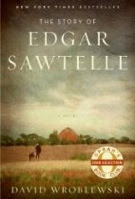
I’m not much good at writing a book review. I’d much rather discuss it with someone who has also read the same thing, but, when I finished reading my pre- release copy – I was given an early heads up by “Book Slut”, a blog I follow — of The Story of Edgar Sawtelle , I became its evangelist, and touted it to everyone who would hold still. I finished the 566 page puppy in early June and since then have given copies as birthday presents (3) and Christmas gifts (4) and prevailed upon seven or eight other folks to read it. Based on their responses I’ve come to realize that there are probably two types of people in the world: those who will love this novel, and those who will hate it. The two opposing camps either say: “ I was up nights late with it, unable to put it down.” ( this was me, too ).
Or:
“To be honest, I hated it. I skipped entire pages of it. The narrative was really boring. He could have cut out half of the pages”. ( its heft alone will prevent many from choosing to read it on a whim. )
I was drawn to Wroblewski’s debut novel for two reasons. First, because dogs play a large part — a large part . The second reason was because I read that the story draws a parallel to Shakespeare’s Hamlet. And so it does. I think to fully enjoy the story’s sensibility one has to believe that dogs are thinking, feeling beings and also accept that the dogs dealt with in the novel are very special, highly intelligent animals. Indeed, Wroblewski goes to great lengths to persuade his readers of these traits, detailing the years spent developing the breed and the grueling hours of training each day it takes to make “a Sawtelle dog". Anyone who can’t accept dogs playing such a large role in a novel of this length isn’t going to be able to stand the book.
Almondine is the dog ( and, interestingly, the Ophelia character ) who nearly raises Edgar (the book’s Hamlet figure). Edgar’s first memory is this:
Between the honey-colored slats of the crib a whiskery muzzle slides forward until its cheeks pull back and a row of dainty front teeth bare themselves in a ridiculous grin.
The nose quivers. The velvet snout dimples... Fine, dark muzzle fur. Black nose, leather of lacework creases, comma of nostrils flexing with each breath... At once, the muzzle he knows is awake. It snorts. Angles right and left. Withdraws. Outside the crib, Almondine’s forequarters appear. Her head is reared back, her ears cocked forward.
A cherry-brindled eye peers back at him.
Whoosh of her tail.
Be still. Stay still.
Much of the novel is like this, simple communication between a boy and a dog. But, there is a complication: Edgar is a mute, so he signs everything to the dogs. The only point in the book where I was tempted to put it away, doubtful that dogs could do such a thing, was when Edgar has the dogs portray the murder of his father, to test his uncle, Claude’s conscience. But, remember this is Hamlet. The play within a play. But acted out by dogs? I was doubtful, but the training of the dogs to do this seemed somewhat plausible, and I willingly let Wroblewski pay the story forward. After all, the dogs memorize a simple sequence:
Roll on your back.
Carry this to the other dog.
Tag that dog.
One aspect of the novel that I feel makes “more” sense than in Shakespeare’s original is the relationship between Trudy ( the Gertrude character ) and Claude ( Claudius ), her deceased husband’s brother. In this story, she’s a complex woman, trying to run a farm on her own in rural Wisconsin in the mid-Twentieth Century. It makes sense for her to accept Claude’s offer to move back to the farm and help her to continue the line of Sawtelle dogs. We get to see far more of the inner workings of this relationship than in Hamlet.
Of course, Wroblewski takes a big risk here. But it’s one that works for me. But I must tell you this: I read much of the book sensing my best friend for eleven years, Joe, my big ol’ black Lab, was reading along with me. The Story of Edgar Sawtelle isn’t for everybody. If you genuinely like dogs and maybe even have pictures of your dog on your desk ... or in your purse or wallet, I think you’ll be delighted with this tale. If not, I don’t know if you’ll make it past the prologue and first chapter. Me? I love dogs. I loved this book. "Saw Tell"(e).

1 comment:
Thanks for the review. Since I am not a dog person, I know this book is not for me.
Post a Comment